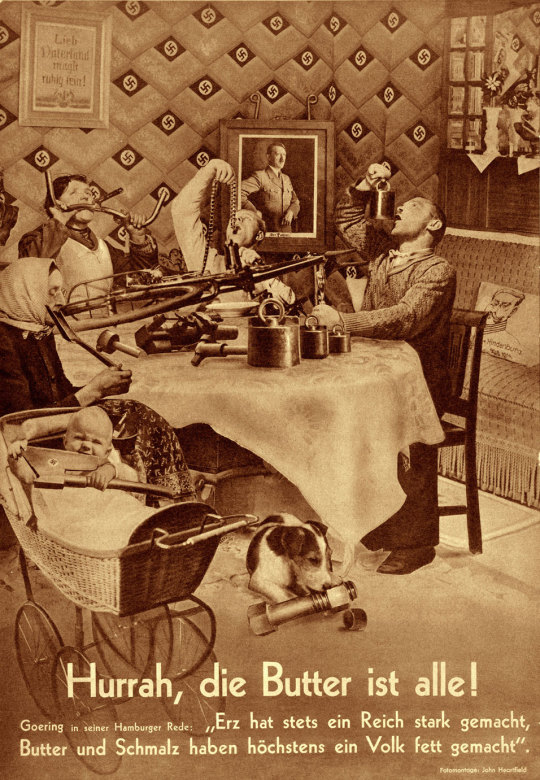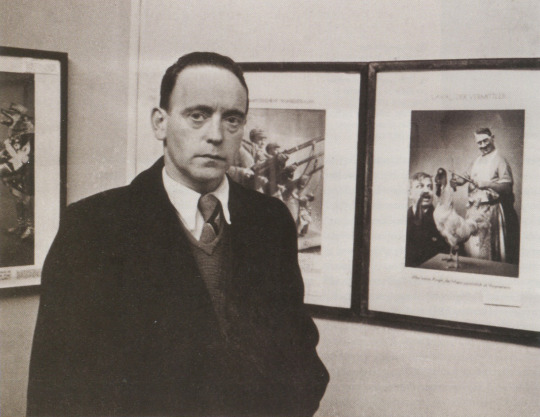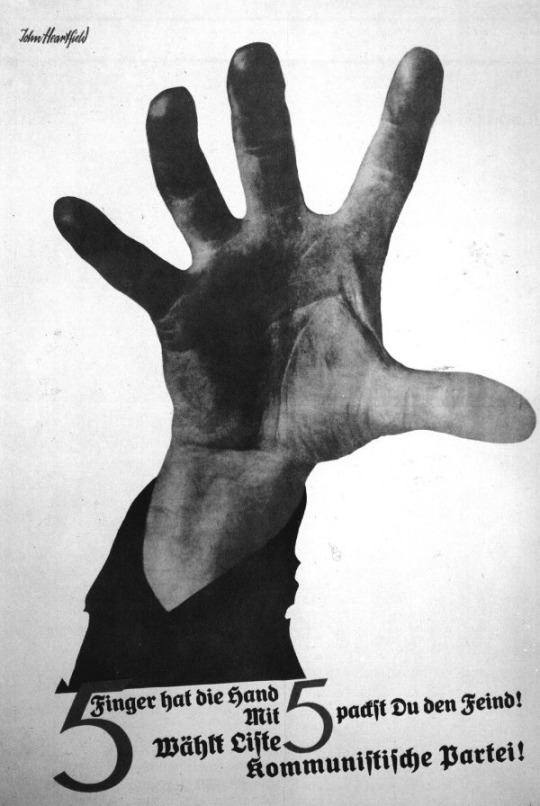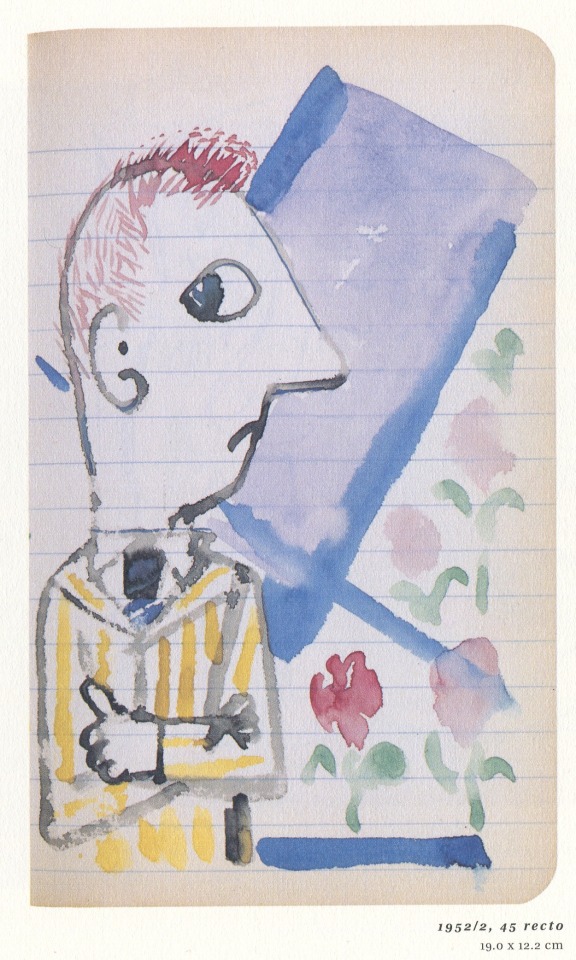Photo

Hurrah, the butter is gone!
Goering in his Hamburg speech: "Iron has always made a nation strong, butter and lard have only made a people fat."
Arbeiter-Illustrierte-Zeitung (Prague), December 19, 1935
John Heartfield was born 123 years ago today.
28 notes
·
View notes
Photo

John Heartfield, Illustration zu Grimm - Märchen von der Katze und der Maus [Illustration for Grimm’s Fairy Tale of the Cat and the Mouse], Volks-Illustrierte (VI, Prague, March 2, 1938)
268 notes
·
View notes
Photo

Masterpieces Of Political Art - John Heartfield
19 notes
·
View notes
Photo

44 notes
·
View notes
Photo

Self-portrait with Police Commissioner Zörgiebel, 1929
It was 1929. The bloody May Day demonstration was shown in the newsreels. Not everything was shown, but some… enough of the savage and brutal actions of Zörgiebel's police, the deliberate and cold-blooded murder of the defenseless workers, to get the idea. Even the good bourgeois audience at the Ufa-Palast am Zoo acknowledged the filmstrip with jeers and whistles. There were also those present that applauded the actions of Zörgiebel's police with demonstrative clapping, including a towering Hun, who was sitting not far from Heartfield. Heartfield jumped up from his seat as if stung by a tarantula and hissed to the broad-shouldered German, "You swine! You swine!" When the performance was over, the Hun, lying in wait for Heartfield, grabbed the small, frail man by the collar: "Now you take back your insult, quickly - what did you say, what am I?" Heartfield, in an iron clamp, defenseless, barely breathing: "You are a swine." The man knocked him to the pavement and hit him repeatedly in the face, furiously demanding: "What am I, what am I?" Him, tight-lipped: "A swine, a swine, a swine" - until he was liberated by the now-swelling crowd of passersby, bloody, bruised, half fainting.
--Wolf Reiss (Janos Reismann), Internationale Literatur 1934, no. 5, quoted in Eckhard Siepmann, Montage: John Heartfield
#john heartfield#photomontage#self-portrait#1929#blutmai#wolf reiss#heartfield in pictures#quote#friends and colleagues
67 notes
·
View notes
Quote
Further evidence of the speed and reach of the police in service to the NSDAP was the attack on the house of Hildegard Scharp. She was an acquaintance of [Heartfield] and the Gestapo took her for his wife by mistake. The day of Heartfield's flight [from Berlin], ten SA and Gestapo broke into her home, pistols in hand and interrogated her for an hour. Thus he learned that his wife and two children would be subjected to Sippenhaft.
Michael Kresja, “Comment les nazis réagirent au travail de Heartfield. 1933-1939,” trans. into French by Claude Riehl, from John Heartfield: Photomontages politiques 1930-1938 (Musées de Strasbourg, 2006)
#john heartfield#1933#nsdap#gestapo#sturmabteilung#barbara heartfield#hildegard scharp#family#persecution#text#quote
4 notes
·
View notes
Quote
On December 6, 1938, [Heartfield] was able to fly to London via Strasbourg and Paris with only ten other emigrants. He thus came to escape the terrible threat of the Gestapo. That the danger was imminent is evidenced by a circular from the President of the Prague Police dated May 5, 1939. It appears that the Gestapo intervention group in Bohemia had been urgently searching since April 24, 1939 for thirty-one people, mostly emigrants. Heartfield appeared at number 5 on the list. Using such lists, the Gestapo, just four days after the entrance of the Wehrmacht into Prague, arrested approximately eight hundred German and Czech Communists.
Michael Kresja, “Comment les nazis réagirent au travail de Heartfield. 1933-1939,” trans. into French by Claude Riehl, from John Heartfield: Photomontages politiques 1930-1938 (Musées de Strasbourg, 2006)
8 notes
·
View notes
Photo

16 notes
·
View notes
Photo

No one who has once seen and spoken to this untidily and shabbily dressed Jew will be surprised, however little much he knows about Jewish physiognomy, that a man with a face of such abysmal ugliness could only bring forth ugliness...
Jews per se were never creative, but could only produce works by copying and exploiting those of others, and this Jew Heartfield was the same. All of his posters, illustrations and so on are photographs; sometimes he also put them together very cunningly, and provided them with captions...
This poster is very effective in its simplicity, and its cleverly written caption adds to the effect. Militant energy is there too, made visible not only in the title but also in the attitude of the hand. Aside from its message, it is a good poster, and was certainly effective.
--Erwin Schockel, Das Politische Plakat (1939)
8 notes
·
View notes
Photo

Victor Hugo, Le Dernier Jour d'un Condamné / The Last Day of a Condemned Man / Die letzten Tage eines Verurteilten
Cover design (and possibly illustration) by John Heartfield, from the Kleine revolutionäre Bibliothek (Little Revolutionary Library) series published by Malik-Verlag, 1920-1923
22 notes
·
View notes
Text
It was in Berlin in 1933, several weeks after the beginning of the fascist darkness over Germany. The leadership of the Bund of revolutionary visual artists had called a small group of active members to an illegal meeting in the little Cafe Kühn at Spittelmarkt. We were about eight in number, including Max Keilson, Alex Keil (a Hungarian immigrant), John Heartfield and, if I'm not mistaken, the art critic [Alfred] Durus.
After undertaking a careful discussion, it may have been about 10:00 PM, we left the cafe and stood outside together for a moment to say goodbye. Immediately, we were besieged from the other side of the street, where a cop on patrol took notice of us in the course of his march and bellowed, "Break it up!"
And then something unexpected happened. John Heartfield, three heads shorter than the lanky policeman, stormed towards him with his head pushed forward, snatched his cap from his head and exclaimed in great agitation: "You, you listen here! -- You have a shako on your head and I've just a cap! -- But under this cap are more brains than under your helmet!" He gesticulated wildly as he uttered these words.
Spellbound, we stared at the two of them. How would this end? Anything was possible, because fascism had already shown its hand.
But nothing of what was to be expected, under the present circumstances, took place. Was it the shock-effect that Johnny's unexpected attack had triggered? The cop, without saying a word, turned round on his heel as if electrified and walked away.
--Alfred Beier-Red, from "John Heartfield -- Meister der Fotomontage," 1961, quoted in Wieland Herzfelde, John Heartfield: Leben und Werk
7 notes
·
View notes
Photo

Portrait, probably of John Heartfield, from The Sketchbooks of George Grosz (ed. Peter Nisbet, 1993)
4 notes
·
View notes
Photo

John Heartfield and Rudolf Schlichter, Preussischer Erzengel (Prussian Archangel), 2004 (reconstruction of lost 1920 original)
papier-mâché (pig’s head); wire mesh (body); palm grass, hemp,
and horse hair (filling); uniform cut from field gray material,
following original pattern; World War I field cap, boots, and shoulder lapels; woodcut (signs)
height c. 180 cm (70 7/8 in.)
Neue Galerie New York
#john heartfield#installation#rudolf schlichter#1920#erste international dada-messe#work#sculpture#dada#dadaism
91 notes
·
View notes
Video
youtube
Never-before-seen video from our new favorite Youtube channel.
2 notes
·
View notes
Text
LETTER FROM AN OLD FATHER TO HIS SON
John Heartfield
My beloved son, you're now a soldier.
I always hoped that you would never be one.
Then the brown plague broke out
and through it the war
and my dream in ruins.
Oh, you know, my son, I too was once a soldier.
In the last war I was forced into the army.
I fought it, I hate war.
Hatred stands ineradicably fast.
You're now a soldier
in this war against those who
still threaten the world,
who would have man as a slave
and as cattle to the slaughter born.
My darling son, I'm no longer permitted
to march as a soldier against the enemies of mankind.
But I'll do whatever I'm able to do
to take part in their destruction.
Be brave, son, life is with thee.
There is nothing nobler than to stand up for life.
The day is already beginning to dawn, the joyful day
we longed for, the day of our reunion.
1941
There's a typewritten draft and another (probably more accurate) translation here, as well as a photo of Heartfield and his son, on the website run by John Joseph Heartfield (John Heartfield's grandson).
Original German text, as printed in Der Schnitt entlang der Zeit (eds. Roland März & Gertrud Heartfield, 1981), below the cut:
Brief eines alten Vaters an seinen Sohn
Mein lieber Sohn, Du bist nun ein Soldat.
Ich wünschte stets, nie sollst Du einer werden.
Da brach die braune Pest aus
und durch sie der Krieg
und mein Wunsch in Scherben.
Ach, Du weißt mein Sohn, auch ich war einst Soldat.
Im letzten Krieg ward ich ins Heer gepreßt.
Ich bekämpfte es, ich hasse Krieg.
Der Haß sitzt unaustilgbar fest.
Du bist nun ein Soldat
in diesem Kriege, gegen die, die
noch die Welt bedrohen, daß der Mensch
als Sklave und als Schlachtvieh werd' geboren.
Mein teurer Sohn, mir ist's nicht mehr vergönnt
als Soldat gegen den Feind der Menschheit zu marschieren.
Doch werd ich tun, was zu helfen mir nur möglich ist
ihren Untergang mit herbei zu führen.
Sei tapfer Sohn, das Leben ist mit Dir.
Es gibt nichts Höheres als für's Leben einzustehen.
Es dämmert schon der Tag, der Jubeltag,
so heißersehnt wie unser Wiedersehen.
10 notes
·
View notes
Photo

#152
John Heartfield: "Leben und Treiben in Universal-City 12 Uhr 5 mittags"
This picture, for which the poet Wieland Herzfelde declares a special fondness, portrays the life and activity in Universal-City by the means of film. This is not a Futurist image, it is in fact a Dadaist image, and an excellent one at that. To get the correct impression, it is best to take 40 steps back through the wall (watch out for the stairs!). Then it will be self-evident that the Dadaist John Heartfield is the enemy of this picture. He has destroyed it himself. A very simple and useful test of this can be done on any street using ordinary lamps.
--Wieland Herzfelde, from the catalog of the First International Dada Fair, 1920
#john heartfield#wieland herzfelde#dada#dadaism#collage#erste internationale dada-messe#1920#quote#work
9 notes
·
View notes
Text
If you knew the small, delicate man with reddish hair, John Heartfield, you would have to love him. He is perhaps still a child, but already a classic. Recently, I called him our Czechoslovakian "adopted enfant terrible" of modern art. [...]
[...] Johnny speaks the way a flea jumps. A leap here, a leap there, and after a while, the subject has grown, divided itself, and after two hours, you do not know where you started...
[...] Always so small and modest. Excitable and restless. Concerned about the purity of his work. Intent on the task he had set himself to accomplish. Complete to perfection. Always ready to deal with incomprehension. Uncompromising. Constantly worried. Always ready to serve. [...] He is a strange, wondrous, admirable, clear-sighted man. So impractical in all small matters of life!
--Adolf Hoffmeister, "Dadamonteur John Heartfield," 1965, quoted in Der Schnitt entlang der Zeit (eds. Roland März & Gertrud Heartfield, 1981)
5 notes
·
View notes